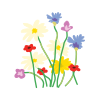Wild flowers, also known as native or indigenous flowers, have an inherent charm that captivates the senses and adds a touch of natural elegance to any garden. These plants are adapted to specific regions and have evolved over time to thrive in local climates and soil conditions. Their diverse colors, shapes, and fragrances create a tapestry of beauty that not only delights the eye but also attracts and supports a myriad of beneficial insects, birds, and butterflies.
How To Grow
Choose the Right Wild Flowers: Before embarking on your wild flower gardening journey, it's crucial to select the right plants for your region. Research native species that are suitable for your specific climate, soil type, and sunlight availability. Local garden centers, botanical gardens, or native plant societies can provide valuable guidance on the best choices for your area. Prepare the Soil: Wild flowers generally prefer well-drained soil with good organic content. Clear the area of weeds, rocks, and debris, and loosen the soil with a garden fork or tiller. Adding compost or organic matter can enhance the soil's fertility and moisture retention capacity. Sowing Seeds: Wild flower seeds can be sown directly in the garden bed during early spring or fall, depending on the species. Follow the specific instructions for each type of wild flower, as they may have different germination requirements. Scatter the seeds evenly over the prepared soil, lightly rake them in, and water gently. Keep the soil consistently moist until germination occurs. Watering and Maintenance: While wild flowers are generally low-maintenance, regular watering is essential during the establishment phase. Once established, they are typically well-adapted to local rainfall patterns and may not require additional watering. However, in times of prolonged drought, supplemental watering can help maintain their vitality. Encourage Biodiversity: To create a thriving habitat for local wildlife, interplant your wild flowers with other native plants and shrubs. This diversity will attract a wider range of beneficial insects, pollinators, and birds, creating a balanced ecosystem within your garden.
How/When To Harvesting
Timing is Key: To enjoy the beauty of wild flower blooms indoors, it's important to harvest them at the right time. Wait until the flowers are fully open and in their prime before cutting. This not only ensures their freshness but also allows the plant to complete its natural reproductive cycle. Use Clean Tools: Before harvesting, make sure your cutting tools, such as scissors or pruners, are clean and sharp. This helps prevent the spread of diseases and ensures clean cuts for optimal vase life. Cut Carefully: Choose healthy stems with open flowers and buds. Cut the stems at a 45-degree angle, just above a leaf node or lateral shoot. This promotes the plant's regrowth and encourages the development of additional blooms. Water and Preservation: Immediately place the freshly cut wild flowers in a bucket or vase filled with clean water. Remove any leaves that will be submerged in the water to prevent bacterial growth. To extend their vase life, change the water every couple of days, recut the stems, and add floral preservatives if desired.


